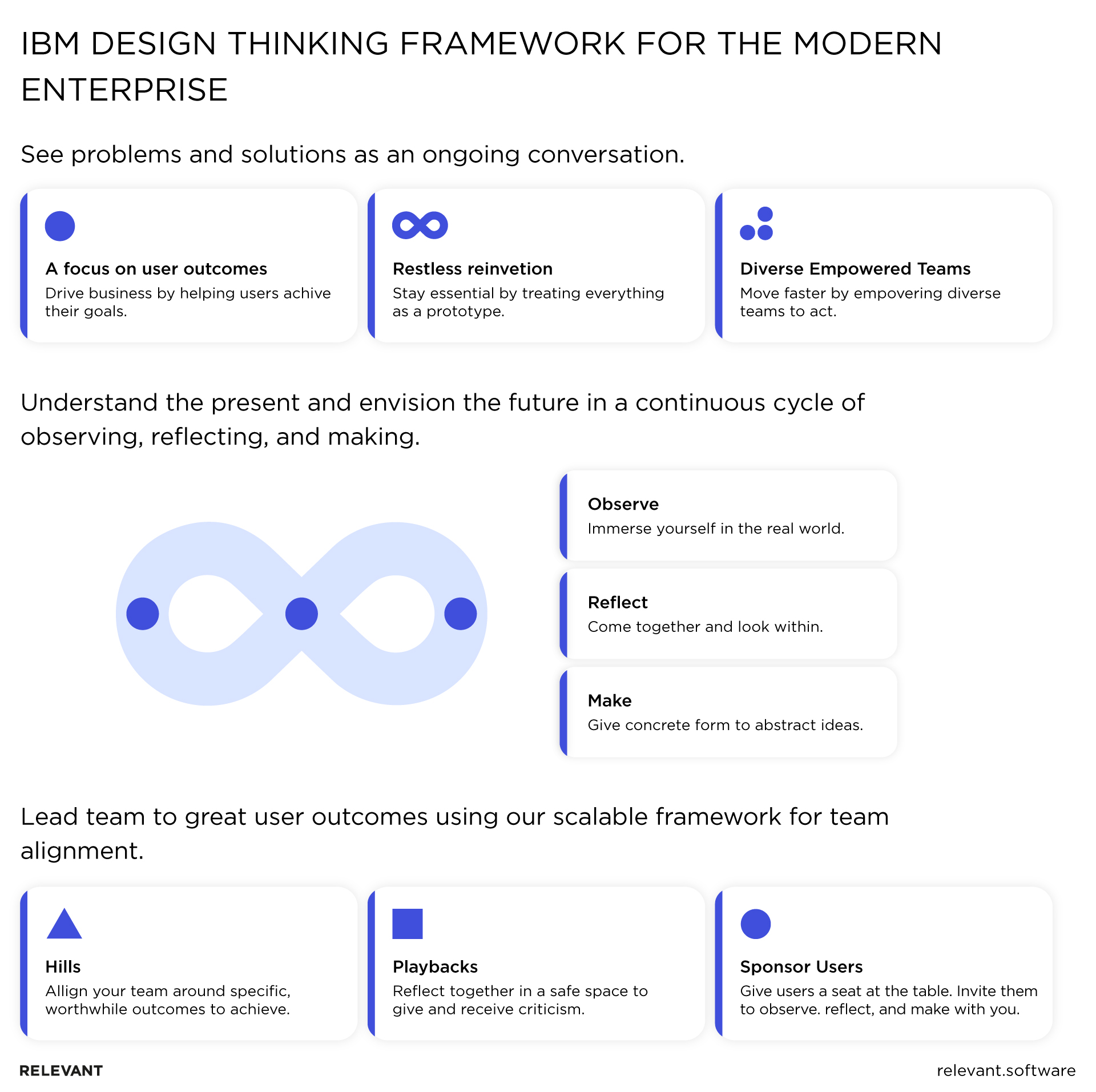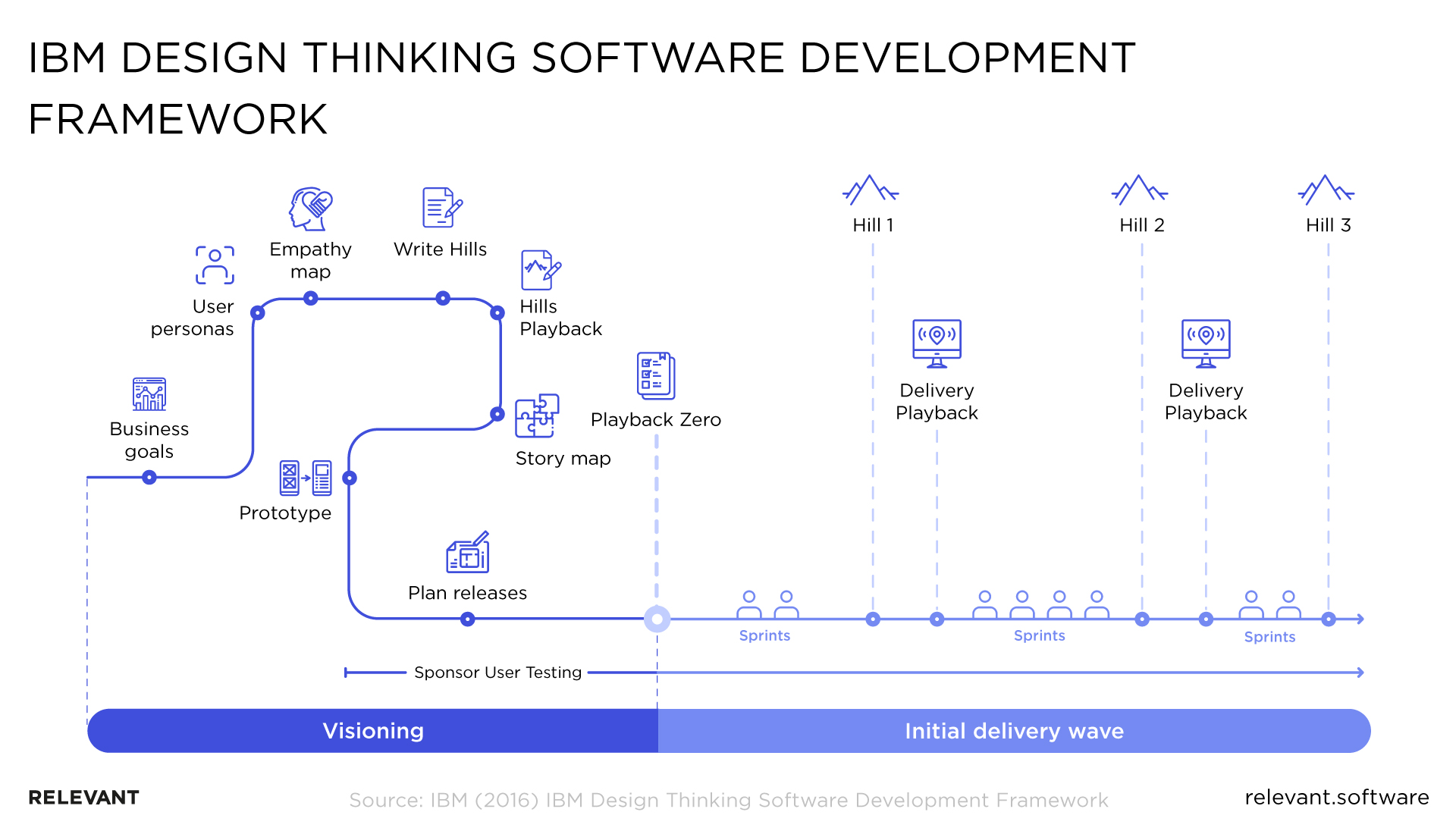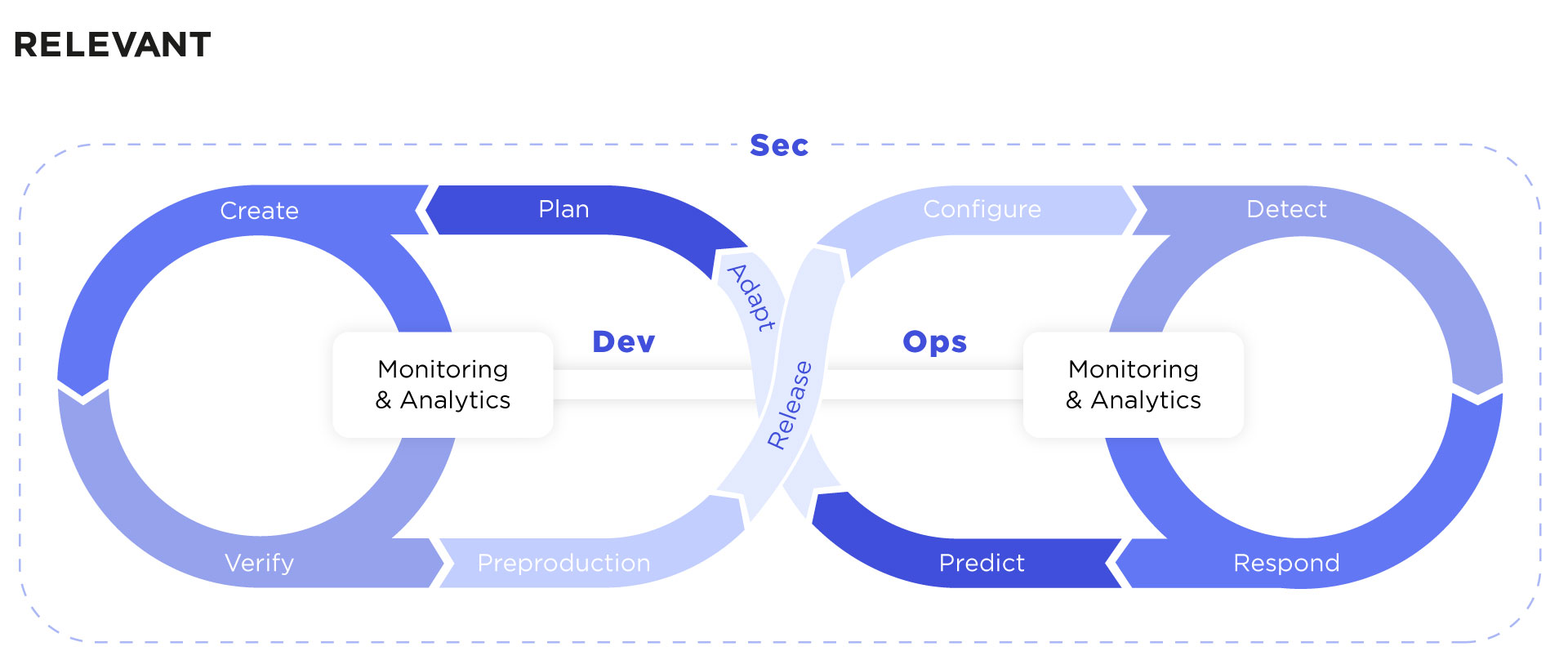The Modern Approach to Enterprise Mobile Application Development
Updated: October 31, 2021
Accessing an enterprise application from a smartphone is every field worker’s dream. Even more, having a mobile enterprise application at one’s disposal is beneficial for all stakeholders, including employees, business owners, and customers. Workflow automation, increased staff efficiency, and a chance of getting the jump on market competitors are just a few advantages of successful enterprise mobile application development.
Relevant Software knows that building an enterprise mobile app can sometimes be challenging. For years our experts have been helping businesses and startups build world-class apps. Now, we’d like to share what issues to expect with enterprise app development and how to overcome them thanks to the modern approach.

We provide companies with senior tech talent and product development expertise to build world-class software. Let's talk about how we can help you.
Contact usTable of Contents
How enterprise mobile application development is different
Enterprise mobile app development is the process of building a mobile application for an enterprise’s needs. An enterprise app’s users are mainly the employees of the organization and its purpose is streamlining business operations.
Since enterprise apps differ from consumer mobile applications, so does their development.
Enterprise apps, like any other corporate systems, deal with corporate databases and frequent data transfers. That’s why they have to be designed with high security and scalability in mind. Also, mobile apps for an enterprise need to be consistent across all devices and platforms even more than consumer apps, because any error can cost the company a lot.
In addition, testing, build automation, and integrating an app into the enterprise’s infrastructure have their peculiarities. On top of that, developing an enterprise application differs in terms of app distribution and legal considerations. This is because you have to comply with app markets’ policies, such as the App Store’s review guidelines.
Enterprise mobile application development challenges
On your way to a successful enterprise mobile app release, you will meet several challenges. Let’s take a closer look at the main ones.
API Strategy
A mobile application talks to the enterprise servers using APIs, so it’s important to get the API strategy right. Unfortunately, API design that balances both great UX for the end-user and security is hard to achieve. Yet it’s crucial for an enterprise mobile app. Because the API in an enterprise app is integrated with business functions it should be held to high-security standards.
Slow Application Development
If you plan on starting an enterprise mobile application from scratch be prepared for a long-term development project. The good news is that your team can benefit from reusable components in low-code development. Or they can use MEAP (mobile enterprise application platform). It allows building cross-platform mobile applications and linking them to enterprise services. Also, you can speed up your software development with a dedicated development team to boost your development capacity.
Integration with Back-End Resources
Integrating a brand new mobile app with existing back-end services can be a real challenge. The thing is, large enterprises can often have outdated back-end services and that will curb development speed and cause problems. In some cases, it may not even be possible to integrate a mobile app with the service.
App Distribution
Mobile app distribution differs from the usual software distribution. There’s no master copy of the app and the whole process is funneled through the app markets. This leads to additional legal work required for enterprise mobile app distribution.
Security
Security is of high priority for a mobile application. The challenge, however, is to make the app as secure as it can be, starting from storing user data securely and up to reducing OS vulnerabilities to a minimum.
What to consider before building a mobile application?
Before jumping right into enterprise app development and design, consider the following issues.
Business objectives
You have to know what kind of product your company needs and how it corresponds to the current business objectives. So before investing in app development, understand what you plan to achieve with a mobile application. Ask yourself who will use it and how. Without a doubt, the application’s functionality and success partially depend on how well you define your goals in enterprise app development.
Administration
Enterprise mobile application development is a complex process. Apart from the development team’s efforts, it requires a lot of administration and legal work to be done by the company. So, before you start looking for software developers, it’s better to decide on who will be in charge of those. Also, don’t forget that the employees need to be trained on how to use the enterprise app.
Security
Bringing enterprise apps to employees’ mobile devices means putting corporate data at risk. For that matter, you have to be aware of possible security issues and create a bulletproof system. Your employees have to be able to login to the app market and transfer any data securely, without endangering corporate information.
Integration with other applications
Deciding on whether to integrate your enterprise mobile app with other applications is a choice you make upfront. The thing is, you may need to integrate the enterprise mobile app with other applications your employees currently use. Take a CRM (customer relationship management) system, such as Hubspot or Salesforce, for instance.
Choosing the platform
You have to decide on which platforms your enterprise application will run and plan the development accordingly. For instance, if your employees are going to use the enterprise mobile app on their own devices you have to head for cross-platform mobile development. This way the enterprise mobile app will work on various devices and platforms.
A modern approach to enterprise mobile application development
In the digital fast-paced era, the company that doesn’t want to lose big to its more innovative competitors has to embrace innovation. This is also true for mobile application development. To maximize the benefits of building an enterprise app you have to follow the modern approach.
Enterprise design thinking
The famous IBM framework called Enterprise Design Thinking is a perfect fit for mobile app development. This approach allows generating ideas, designing, developing, and delivering enterprise mobile solutions fast. Enterprise design thinking combines the elements of the design thinking methodology and traditional design techniques.
The core practices of Enterprise Design Thinking are hills, playbacks, and sponsor users.

Hills mean user outcomes. Instead of focusing on feature requests, we have to focus on desired, measurable outcomes in mobile app design and development. Each project should have release hill objectives and one for the technical foundation.
Playbacks are about iteration. Put simply, you need to get feedback and revise your design if you want to move forward with it. Playbacks ensure that your team aligns the processes with the objectives.
Sponsor users are the representatives of the app’s user group. It’s better to get feedback from potential users than only working with personas. Try including such users at different development and design stages.
Apart from these innovative practices, Enterprise Design Thinking also includes well-known design techniques: personas, empathy maps, as-is scenarios maps, to-be scenarios, design ideation, wireframe sketches, hypothesis-driven design, and minimum viable product definition. The good news is, you can delegate all of these to a trusted outsourcing partner, such as Relevant Software.

According to Forrester, IBM’s Enterprise Design Thinking has proven to be highly beneficial. Applying this framework reduces the time required for gathering and aligning with initial requirements by 75% and project development and testing time by 33%. Moreover, Enterprise Design Thinking reduces the number of design defects by 50%.
Design for mobile, think cross-platform
With an enormous change brought by the introduction of mobile devices, “mobile first” became the established principle in designing applications. But the truth is, you have to consider the peculiarities of the mobile.
Instead of building the most technically challenging enterprise app that has lots of functions, think about the ways people will use it. Why will users need the app in the first place? How will they interact with it? What kind of devices will they use? Those are the questions that need to be answered at the very beginning of mobile app design.
No doubt, you have to create a cross-platform app. Not only one which covers different mobile OS’s but also one that takes other user’s devices into account. For instance, your employees will probably use mobile apps for an enterprise on the go. But what if they want to switch to their laptop at some point? To ensure a smooth transition between different platforms, build a multi-device app.
Test everything
Testing and quality assurance (QA) are vital for mobile app development. QA practices prevent mobile products from having any defects and being delivered to users with numerous bugs. According to the World Quality Report 2018, 42% of respondents stated that end-user satisfaction is the main objective of QA. The average spendings on QA are 26% of a company’s IT budget.
When it comes to mobile app testing you have to leverage the modern continuous testing approach. In essence, it means “test a lot and often”, not just before the app release. It also means running both automated and manual tests to exclude the possibility of enterprise app failures. Automated tests help developers track the problems early and let them focus on other tasks. While manual testing is essential for creating good app UI/UX.
Continuous testing should be a part of the CI/CD pipeline. Your team has to test continuously throughout the whole app development and even more. Don’t forget that after preproduction testing comes post-release testing which is dangerous to ignore. Post-release testing means verifying the release on live environments and it’s necessary for enterprise mobile app development. The reason is, post-release testing allows tracking data and deployment issues.
Leverage cloud and microservices
Cloud-based applications are one of the hottest trends in application development. Migration to the cloud offers many benefits, such as reduced time-to-market, enhanced performance, application scalability, and reduced development costs. The same is true for cloud-based mobile app development.
For an enterprise app, mobile cloud computing allows the integration of large data volumes. By using cloud services, users can collect and exchange data with various sources fast. This results in fast employee communication and streamlined work processes.
Moreover, cloud-based mobile apps are scalable both up and down. This means that you can easily adjust its capacities in case of your services’ expansion or high workloads. In addition, cloud-based development is cost-effective. Building a mobile app in the cloud allows you to save costs on infrastructure.
Apart from cloud computing, you should consider the microservices architecture pattern for your enterprise app. Although it’s popular mostly for building web services, microservices architecture is applicable in mobile development as well. You can break your application into several independent small services, each with its own functionality. This approach allows you to build, manage, maintain, and deploy the mobile application better. Microservices are especially useful if you plan on building a large enterprise application with complicated functionality.
Implement DevOps and CI/CD
Today, enterprise mobile app development requires DevOps automation and CI/CD pipeline implementation, especially if you are using any cloud services. DevOps stands for development and operations. It means a set of practices that combines the two for the sake of high software quality. DevOps helps to speed up the development process and manage complicated apps efficiently.
Take a look at the best DevOps practices:
- Plan and track everything to manage the current processes better
- Dashboard everything to control development
- Version everything to track the updates
- Automate everything to streamline the workflow
- Test everything to fix the issues early in development
- Monitor everything to minimize the chance of failed deployments
Adopting DevOps and CI/CD in mobile app development is beneficial. Mobile DevOps enables frequent app updates and releases. Also, it leads to less app failure.
Unfortunately, on your way to enterprise mobile app deployment, you’ll likely meet the following DevOps challenges:
- fragmented platforms
- complex enterprise back office
- an asynchronous deployment step added by the App Store
- security issues
- code signing
- keystores testing
Still, you can overcome the challenges if you implement some of the best DevOps practices, such as:
- continuous integration/delivery
- automating builds and deployments
- testing each build
- simulating backend services to expand testing environment availability
- monitoring deployed application and backend server performance
- centralizing governance of provisioning profiles
- use a private app store to test deployment devices
- API keys
- converting real user feedback to enhancements
You may be interested in how to hire a dedicated CI/CD engineer.
Integrate security into the development (DevSecOps)
With 24,000 malicious mobile applications blocked each day, mobile devices put sensitive data at risk. That’s why security should be the number one priority when it comes to enterprise mobile development. Today, running basic app security checks is not enough. Secure coding should become the approach of choice for your development team.
DevSecOps stands for development, security, and operations. It’s a methodology that incorporates security at all stages of app development, not just in the end. In DevSecOps, security protocols become the primary ingredient of the app development lifecycle. Software is continually monitored for threats and the development team constantly improves the protection.

By integrating the security component into CI/CD practices development teams can protect their applications better. For instance, they can detect vulnerabilities at early development stages and fix them at a lower cost. Also, they can manage risks and reduce legal liability. Moreover, this approach allows using open-source packages with an automated tool to track harmful components. In addition, you can save costs on resource management.
Example of enterprise mobile app architecture
Here’s how a typical enterprise mobile app architecture looks.

How Relevant can help you develop mobile apps for an enterprise
In the modern world, every company has to keep up with innovation to succeed. Creating mobile apps for an enterprise is a step towards digitalization. Moreover, it’s an investment in the organization’s competitiveness. Not to mention that developing an enterprise app allows you to streamline the workflow and save resources.
Even though enterprise mobile application development has many pitfalls, such as API strategy, slow application development, integration with back-end resources, app distribution, and security, its benefits outweigh the challenges. So, if your company doesn’t have an enterprise mobile application yet, you should invest in one. The main question here is: can you afford not to?
With 7 years and more than 200 projects delivered, Relevant Software is a trusted software development services vendor. Our expertise includes software development, mobile application development, DevOps, DevSecOps, cloud, and cybersecurity. We know how to build scalable cloud-based and secure applications that users fall in love with. Contact us to set up a dedicated full-stack product team for your project.
Our core services:
Do you want a price estimate for your project?
Do you know that we helped 200+ companies build web/mobile apps and scale dev teams?
Let's talk about your engineering needs.
Write to us











